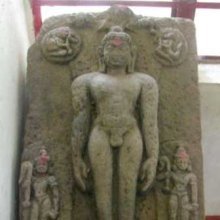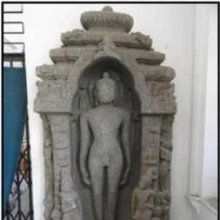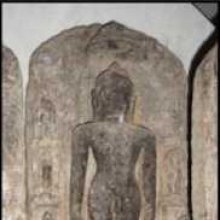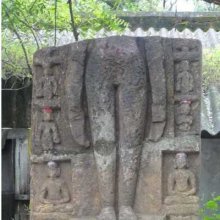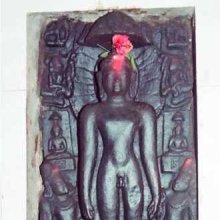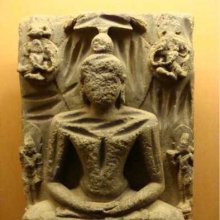Ajitanatha, Ajitanātha: 3 definitions
Introduction:
Ajitanatha means something in Jainism, Prakrit. If you want to know the exact meaning, history, etymology or English translation of this term then check out the descriptions on this page. Add your comment or reference to a book if you want to contribute to this summary article.
Images (photo gallery)
(+2 more images available)
In Jainism
General definition (in Jainism)
Source: Wisdom Library: JainismAjitanātha (अजितनाथ) is another name for Ajita, the second Tīrthaṅkara (Janism recognizes 24 such teachers or Siddhas). His colour is gold (kāñcana), according to Aparājitapṛcchā (221.5-7). His height is 450 dhanuṣa (a single dhanuṣa (or, ‘bow’) equals 6 ft), thus, roughly corresponding to 823 meters. His emblem, or symbol, is an Elephant.
Ajitanātha’s father is Jitaśatru and his mother is Vijayā. It is an ancient Jain practice to worship the Tīrthaṅkara’s parents in various rites, such as the pratiṣṭhāvidhi, according to the Ācāradinakara (14th century work on Jain conduct written by Vardhamāna Sūri).
Source: archive.org: The Jaina IconographyAjitanātha (अजितनाथ) refers to the second of twenty-four Tīrthaṃkaras or Jinas, commonly depicted in Jaina iconography.—The Jaina original books give him the symbol of elephant (Gaja) and his other symbol, namely his special tree (kevalavṛkṣa) tree both being connected with his images. Further, two other iconographic points by which Ajitanātha’s statues may be differentiated from those of others are the figures of his particular Yakṣa called Mahāyakṣa and his Yakṣiṇī named Ajitabalā. Mention of these is made in the Jaina canonical Literature. His posture is what is technically known as khaḍgāsana i.e., standing with two arms hanging on the sides. His chowrie-bearer is Sagaracakrī.
The origin of his symbolism and his name can be traced to the Jaina books. The Jina’s mother saw an elephant in herseveral dreams. An elephant in India is always connected with kingly power. After his birth all his father’s enemies were conquered (Jita), hence his name the “invincible” one. The Śvetāmbara author Hemachandra interprets his name as “not conqueredby excrement of the bowels etc.”.
The Digambara authoritative book, the Uttarapurāṇa explains the word Ajita as “not conquered by sin or by all heretics”. Thus, all the facts and ideas primarily connected with the life and teachings of this Jina, converge to one point “invincibility”, “conquest”. His elephant emblem, his Yakṣa’s just the identical emblem together with the warlike symbols of spear, goad, club etc., his Yakṣiṇī’s symbols noose, goad etc eminently express the idea of temporal conquest, on one hand, the symbols of rosary, Varada-mudrā, and Abhaya-mudrā on the part of the Yakṣa and Varada-mudrā on the part of the Yakṣiṇī, the idea of spiritual conquest on the other.
Source: academia.edu: Tessitori Collection IAjitanātha (अजितनाथ) or Ajitanāthagīta refers to one of the twenty-four songs (gīta) embedded in the Caturviṃśatijinagīta by Jinarāja (dealing with classical hymns and stotras from Jain literature), which is included in the collection of manuscripts at the ‘Vincenzo Joppi’ library, collected by Luigi Pio Tessitori during his visit to Rajasthan between 1914 and 1919.

Jainism is an Indian religion of Dharma whose doctrine revolves around harmlessness (ahimsa) towards every living being. The two major branches (Digambara and Svetambara) of Jainism stimulate self-control (or, shramana, ‘self-reliance’) and spiritual development through a path of peace for the soul to progess to the ultimate goal.
See also (Relevant definitions)
Starts with: Ajitanathagita.
Full-text (+491): Ajita, Pushkaravarta, Airavatavarsha, Haimavatakshetra, Mahavidehakshetra, Airavatakshetra, Haimavatavarsha, Ramyakakshetra, Videhavarsha, Bharatavarsha, Mahavidehavarsha, Hairanyavatakshetra, Kaloda, Kevalavriksha, Anika, Abhiyogya, Samsthana, Prakirna, Kilbisha, Paroksha.
Relevant text
Search found 5 books and stories containing Ajitanatha, Ajitanātha; (plurals include: Ajitanathas, Ajitanāthas). You can also click to the full overview containing English textual excerpts. Below are direct links for the most relevant articles:
Matangalila and Hastyayurveda (study) (by Chandrima Das)
Elephants in Jain Mythology < [Chapter 4]
Jainism in Odisha (Orissa) (by Ashis Ranjan Sahoo)
Jaina Antiquities in Charampa (Bhadrak) < [Chapter 3: Survey of Jaina Antiquities in Odisha]
Jaina Antiquites at Chandi Devi Temple, Baruadi < [Chapter 3: Survey of Jaina Antiquities in Odisha]
Risabhanatha image at the Gramadevati Shrine, Ramachandrapur < [Chapter 3: Survey of Jaina Antiquities in Odisha]
Jain Remains of Ancient Bengal (by Shubha Majumder)
Images of Tīrthaṅkara Ajitanātha < [Chapter 6 - Iconographic Study of Jaina Sculptural Remains]
Jain images from Ancient Bengal (Introduction) < [Chapter 6 - Iconographic Study of Jaina Sculptural Remains]
The twenty-four Tīrthaṅkaras and their Yakṣas and Yakṣiṇīs < [Chapter 6 - Iconographic Study of Jaina Sculptural Remains]
Trishashti Shalaka Purusha Caritra (by Helen M. Johnson)
Part 1: Invocation < [Chapter I - Previous incarnation as Vimalavāhana]
Introduction to volume 2 < [Introductions]
Part 5: Initiation of Jitaśatru < [Chapter III - The initiation and omniscience of Ajita]
Bhagavati-sutra (Viyaha-pannatti) (by K. C. Lalwani)
Part 3 - On patriarchs < [Chapter 5]
